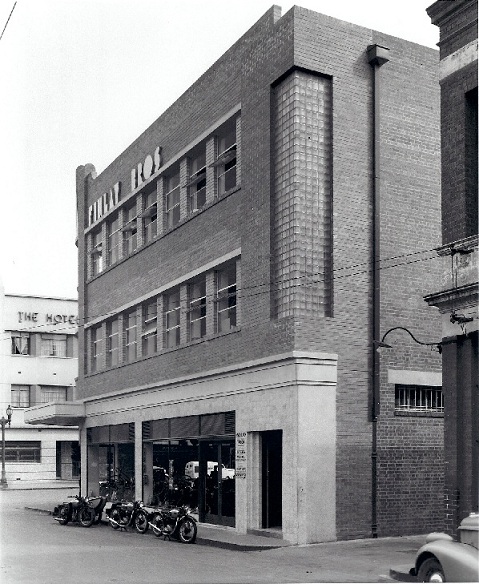
Lyle Fowler
Pictures Collection, State Library of Victoria
| In compiling this information, we have been fortunate to be able to include the recollections and excerpts from the unpublished memoirs of Keith Gales. Keith was an employee of Finlay Brothers from 1948 until 1960, and we are very grateful for his assistance in preparing the following descriptions.
At the rear of the Finlay Brothers premises - running parallel with Elizabeth Street - was a narrow laneway called Knox Place. The photograph to the right shows the entrance to this laneway - at the far right.
Exterior view of Workshop:
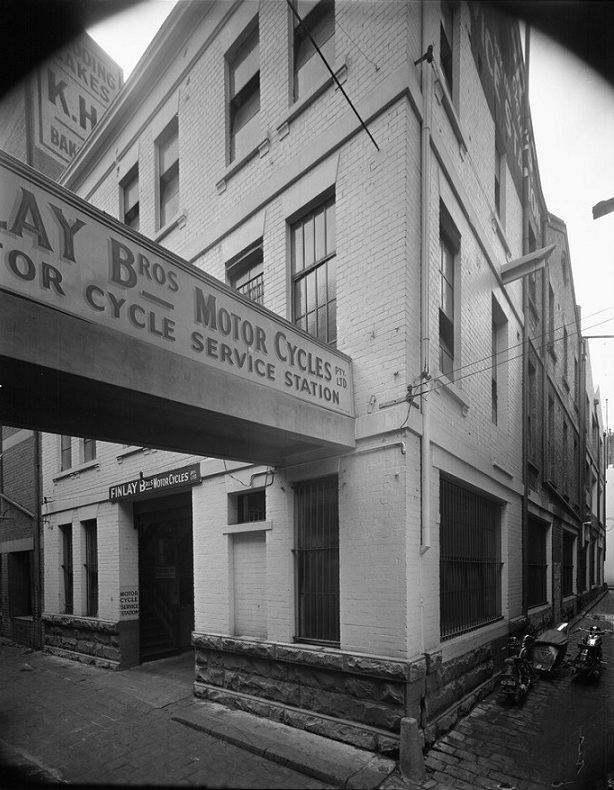
A view of the exterior of the Workshop - probably 1930's.
Commercial Photographic Company, Pictures Collection, State Library of Victoria
The Finlay Brothers’ Workshop was located almost directly behind their main Elizabeth Street premises - across a laneway -Knox Place. The Workshop was connected to the main Finlay Brothers showroom by a walkway (at the level of the first floor) – as seen above with the signwriting on it.
Ground floor of Workshop:
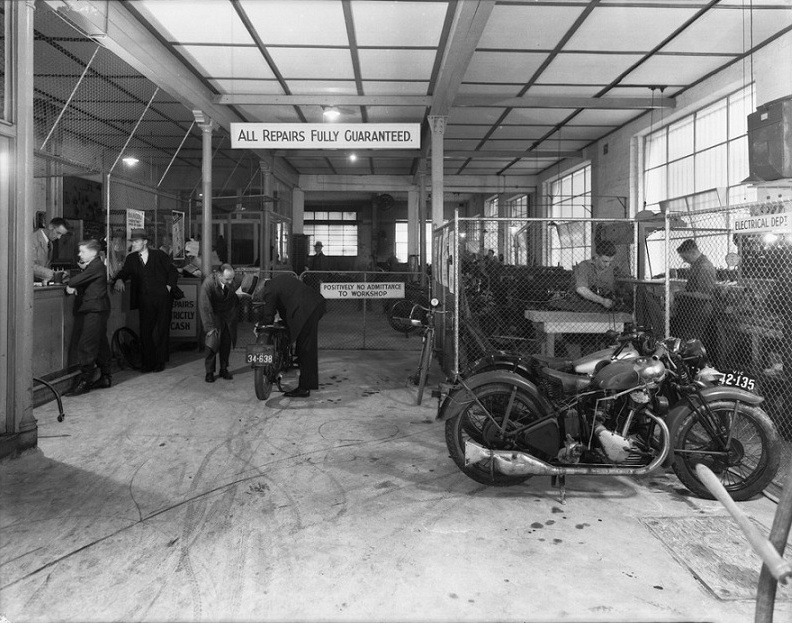
Commercial Photographic Company, Pictures Collection, State Library of Victoria
This photograph was taken looking through the front entrance of the Workshop into the ground floor level.
On the left side of the photograph, customers are standing at the Workshop Office, behind that is the Workshop Store, then the Rebore Department is the furthest closed in area seen on the left side.
On the right side, the Electrical Department is seen closest to the front, followed by the Motorcycle Repair Section. The Welding and Blacksmith Department was at the very rear of the building.
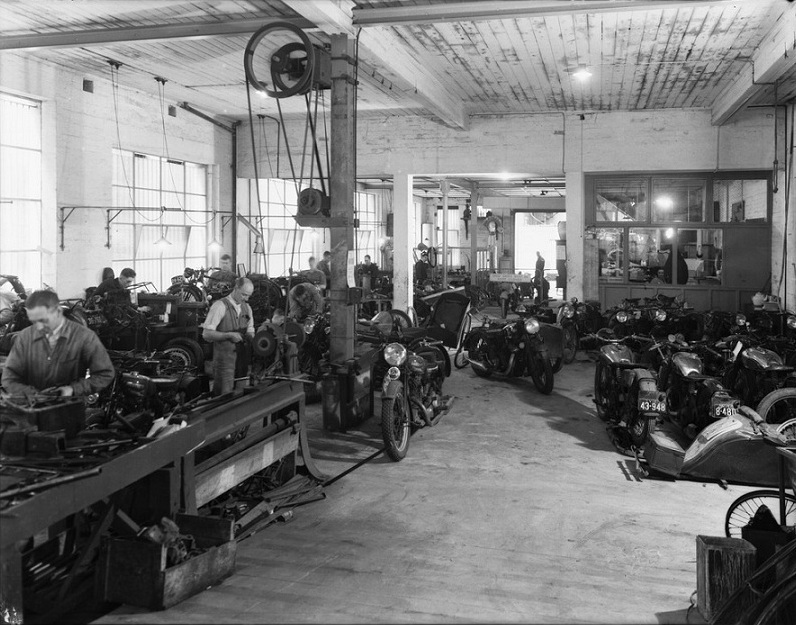
Commercial Photographic Company, Pictures Collection, State Library of Victoria
This photograph was taken from the rear of the ground floor looking out toward the front door. The compressor, staff lockers and storage area for motorcycles (for repair) were all on the right of this view.
The Rebore Department is the closed in area on the right with the lights shining.
Most motorcycle repairs were done on the ground floor, and the work areas included:
- Workshop Office – “was just inside the door, under the steps that went to the upper floors; it must have been noisy as we would run up and down those wooden steps to the spare parts, toilets etc two steps at a time.”1 The Workshop Office was staffed by the Workshop Manager, a Costing Clerk, and two female office staff. The Workshop foreman “had a desk in there but most of his time was where he booked the jobs in and interviewed the customers outside the Store window.”2
- Workshop Store – “The store was where the repair jobs were booked in…All of the incoming and outgoing parcels were handled in the store. The staff had to be clocked on and off by… the storeman. The special workshop tools, nuts, bolts, gasket material, goo and cement, (we usually had to make our own gaskets in those days), oils, grease and odds and sods etc. were stored there. The mechanics came to the small store window to get what they needed. For special parts for the repairs we had to go upstairs and across a foot bridge to the main front building first floor store…”3
- Motorcycle Repair Section – An area where about nine mechanics and apprentices worked at nine individual work benches. In about 1957, the Workshop was updated with benches along the wall. Each mechanic had another low bench to put the bike on which he was working on, to work about 15 inches off the floor.
- Rebore Department – “There was the rebore department next to the workshop store… [it] was always busy, work came in from dealers all over Victoria and the Riverina…There was usually a staff of about four in the rebore department.”4 This department later moved (in about 1957) to the second floor where the Cycle Department had been, after the bicycles had stopped being made. It was moved to the first floor because there was more room there for a very large crankshaft grinder to be installed in the department. Part of the front wall had to be removed for the grinder to fit through, and it is recalled that the event was photographed and reported in the newspapers at the time.
- Welding and Blacksmith Department – “…was the blacksmith and did most of the panel beating and straightening of the smashed motor cycle frames and all of the welding. He had a large gas forge with a large electric blower powering it. We all used that at times.”5 A wall was later added to this area.
- Electrical Department – “a small cubby house in the front corner…”.6 This area was later demolished to make room for the Manager’s Office, and another office for the Foreman, Costing Clerk and office staff.
- Compressor – Located behind the Rebore Department.
- Storage – “Beside the compressor was a large storage area for the motorcycles awaiting repair. It was a busy workshop and there were always plenty of motor-bikes there about four rows deep… …[the pick up and delivery rider] used to collect some of the smashed bikes in his side box, others came in on tow trucks and there was always a lot of insurance work.”7
- Lift – Motorcycle crates which came from England were lifted to the upper floors on the hydraulic lift at the rear of the building.
“Finlay’s had a goods lift that was powered by hydraulic water power supplied by pipe from the council; it had a central pipe just like the normal hoist at a Service Station only a lot longer. I imagine that’s how most of the city’s lifts worked back then. This lift was very slow and unreliable, it was always getting serviced and repaired. You had to put your arm through a slot in the lift wall and pull on a rope to get it started, you could reach the rope from all floors and if all of the lift doors were shut you just put your arm in the slot, pulled on the rope and the lift would come to you, when it was level with the floor you put your arm in and pulled the rope to stop. If the door wasn’t level with the floor theoretically the door wouldn’t open, but that wasn’t always the case. The lift couldn’t be trusted and sometimes you could be using the lift and someone on another floor would pull the rope and the lift would start even with the door opened and you would have to yell and jump out of the way. …Sometimes we had the lift completely filled with crates of motorcycles, it took very heavy loads and we sometimes took cars in it. One time I had a motorcycle and sidecar half way in the lift and the lift took off and the front of the bike went up and when the lift got too high the front of the bike fell down crashing on to the sump of the bike and overhanging the lift well.”8
- Rear sliding door – At the back of the Workshop was a door which opened to a laneway at the rear. A ramp was added during the mid 1950’s
when more makes of cars were being sold and serviced - “[an employee] did a factory course and the workshop was altered at great expense so as to get the cars in the rear workshop building from the back lane. We were to be the closest Standard agent to the city and they were a very good car. We had the Standard 8, Standard 10 Cadet and the Vanguard.”9
Photographs of ground floor work areas:
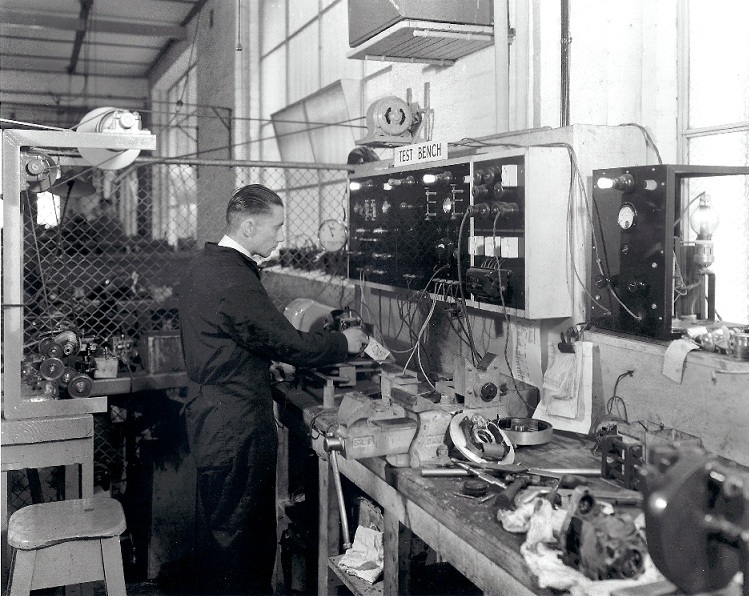
Adrian Crothers, Pictures Collection, State Library of Victoria
This photograph shows the Electrical Department at the very front of the Workshop - right side.
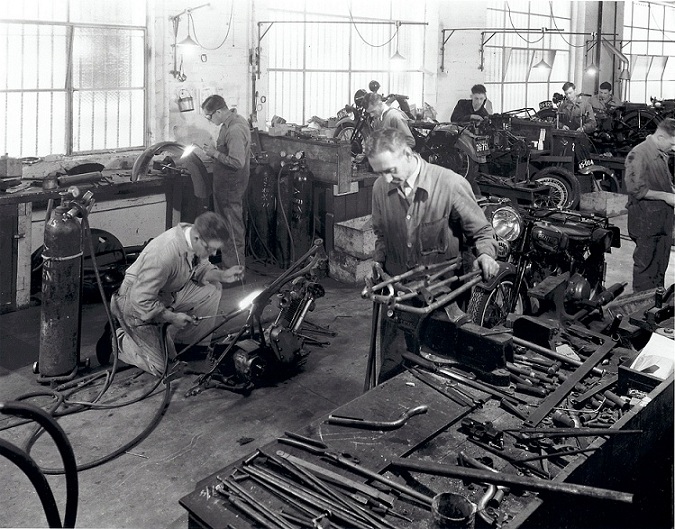
Adrian Crothers, Pictures Collection, State Library of Victoria
This photograph shows the Motorcycle Repair Section at the right side of the scene, and the Welding and Blacksmith Department on the left side. It is taken looking towards the front of the Workshop, showing the right side wall.
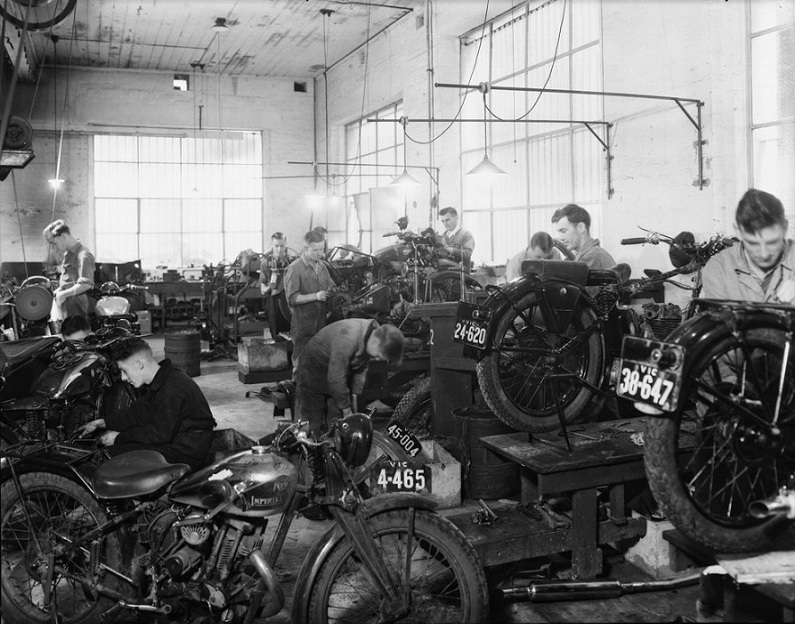
Commercial Photographic Company, Pictures Collection, State Library of Victoria
This photograph shows the Motorcycle Repair Section in the foreground, and the Welding and Blacksmith Department toward the right rear corner.
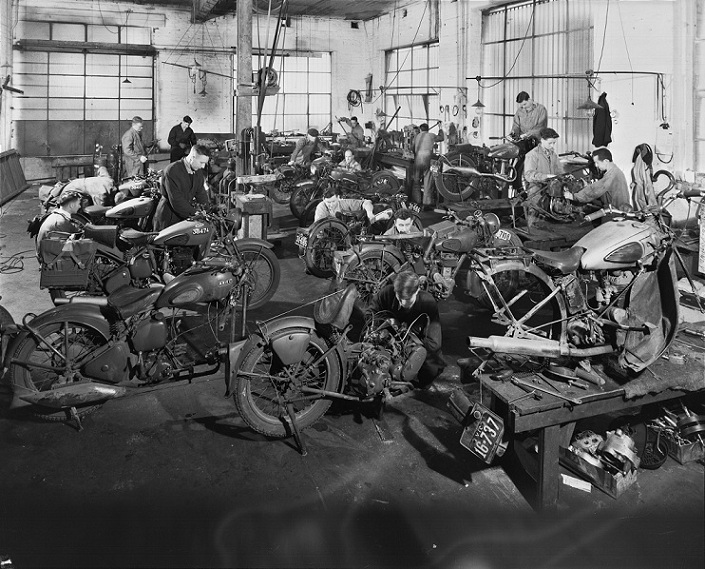
Lyle Fowler, Pictures Collection, State Library of Victoria
This photograph shows the Motorcycle Repair Section in the foreground, and Welding and Blacksmith Department in the right rear corner. The Workshop’s rear sliding door is visible at the far left. This scene shows fifteen staff at work amongst the bikes. One of the bikes is a wartime BSA, suggesting perhaps the 1942-45 era.
Please read on further - more information about the Workshop's first and second floors can be found on our website here.
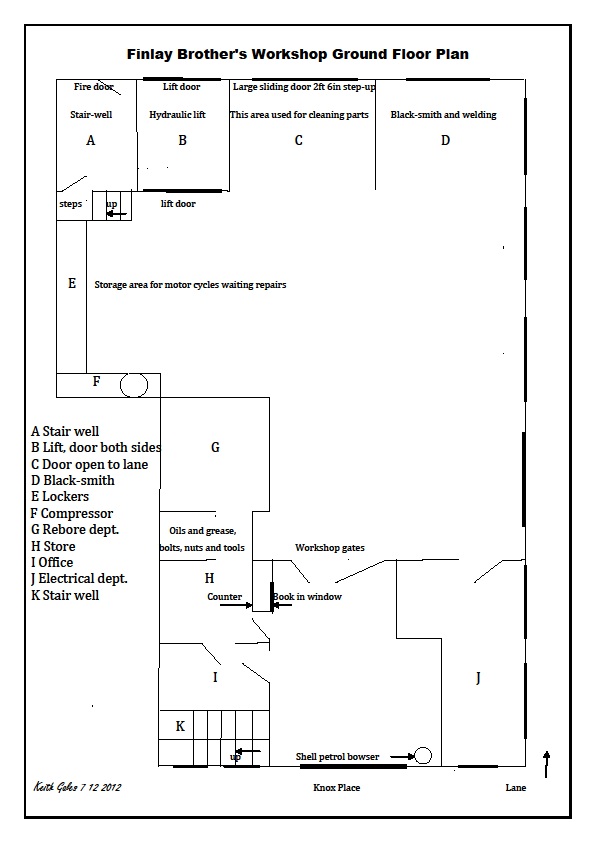
References:
1. Keith Gales, Unpublished memoirs (2010), p 3 of Chapter 2.
2. Keith Gales, Unpublished memoirs (2010), p 2 of Chapter 2.
3. Keith Gales, Unpublished memoirs (2010), pp 2-3 of Chapter 2.
4. Keith Gales, Unpublished memoirs (2010), p 4 of Chapter 2.
5. See note 4 above
6. See note 4 above.
7. Keith Gales, Unpublished memoirs (2010), p 5 of Chapter 2.
8. Keith Gales, Unpublished memoirs (2010), p 12 of Chapter 2.
9. Keith Gales, Unpublished memoirs (2010), p 21 of Chapter 2. |